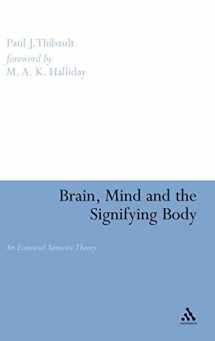
Brain, Mind and the Signifying Body: An Ecosocial Semiotic Theory (Open Linguistics)
ISBN-13:
9780826469656
ISBN-10:
0826469655
Author:
Paul Thibault
Publication date:
2004
Publisher:
Continuum
Format:
Hardcover
360 pages
FREE US shipping
Book details
ISBN-13:
9780826469656
ISBN-10:
0826469655
Author:
Paul Thibault
Publication date:
2004
Publisher:
Continuum
Format:
Hardcover
360 pages
Summary
Brain, Mind and the Signifying Body: An Ecosocial Semiotic Theory (Open Linguistics) (ISBN-13: 9780826469656 and ISBN-10: 0826469655), written by authors
Paul Thibault, was published by Continuum in 2004.
With an overall rating of 4.1 stars, it's a notable title among other
Foreign Language Study & Reference
(Linguistics, Words, Language & Grammar , Semantics, History & Surveys, Philosophy) books. You can easily purchase or rent Brain, Mind and the Signifying Body: An Ecosocial Semiotic Theory (Open Linguistics) (Hardcover) from BooksRun,
along with many other new and used
Foreign Language Study & Reference
books
and textbooks.
And, if you're looking to sell your copy, our current buyback offer is $0.3.
Description
Brain, Mind and the Signifying Body is an exploration of a multimodal theory of cognitive science. Using linguistic theories first developed by Saussure and more latterly by M. A. K. Halliday, Paul Thibault analyses how social and biological systems interact to produce meaning. This fascinating study will be of interest to undergraduates and academics researching cognitive linguistics and advanced semiotics. The book engages with the current dialogue between the human and life sciences to ask questions about the relationship between the physical, biological aspects of a human being, and the sociocultural framework in which a human being exists. Paul J. Thibault argues that we need to understand both the semiotic, discursive nature of meaning making, and the physical context in which this activity takes place. The two are inseparable, and hence the only way we can understand our subjective experience of our environment and our perceptions of our inner states of mind is by giving equal weight to both frameworks. This 'ecosocial semiotic' theory engages with linguistics, semiotics, activity theory, biology and psychology. In so doing, the book produces a new way of looking at how a human being makes sense of his or her environment, but also how this environment shapes such meanings.


We would LOVE it if you could help us and other readers by reviewing the book
Book review

Congratulations! We have received your book review.
{user}
{createdAt}
by {truncated_author}


